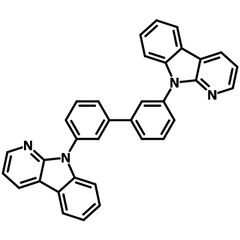CbBPCb
CAS Number 1469997-91-8
High Purity Sublimed Materials, Host Materials, Semiconducting Molecules, TADF Materials
CbBPCb, highly efficient bipolar phosphorescent host
Can achieve high quantum efficiencies in blue PhOLEDs
CbBPCb, having similar structure to the well-known host material mCBP, is a highly efficient carboline-based phosphorescent host with oligophenyl spacer. CbBPCb is bipolar, but shows a higher electron mobility of 3.83×10-6 cm2 V-1 s-1 than its hole mobility of 6.33×10-7 cm2 V-1 s-1.
With a wide bandgap and high triplet energy level, CbBPCb can achieve high quantum efficiencies of over 30.0% in blue phosphorescent organic light emitting diodes. This is due to the host-guest energy transfer, balanced charge injection / transporting and effective exciton confinement within the emitting layer [1, 2]
General Information
| CAS number | 1469997-91-8 |
|---|---|
| Chemical formula | C34H22N4 |
| Molecular weight | 486.57 g/mol |
| Absorption | λmax 240 nm, 297 nm (THF) |
| Photoluminescence | λem 382 nm (THF) |
| HOMO/LUMO | HOMO = 6.25 eV, LUMO = 2.79 eV; ET = 2.77 eV [1] |
| Chemical name | 3,3'-Di(9H-pyrido[2,3-b]-indol-9-yl)biphenyl |
| Synonyms | mCbBP |
| Classification / Family | Carboline derivatives, Phosphorescent host materials, Sublimed materials, Semiconducting small molecules |
Product Details
| Purity | Sublimed >99.0% (HPLC) |
|---|---|
| Melting point | mp = 251 °C, Tg = 96 °C (lit.) |
| Appearance | Off-white powder/crystals |
*Sublimation is a technique used to obtain ultra pure-grade chemicals. For more details about sublimation, please refer to the sublimed materials.
Chemical Structure

Device Structure(s)
| Device structure | ITO (50 nm)/PEDOT:PSS (60 nm)/TAPC (20 nm)/mCP (10 nm)/CbBPCb:10wt% FIrpic (25 nm)/TSPO1 (35 nm)/LiF (1 nm)/Al (200 nm) [2] |
|---|---|
| Colour |
|
| Max. Current Efficiency | 53.6 cd/A |
| Max. EQE | 30.1 |
| Max. Power Efficiency | 50.6 Im/W |
Pricing
| Grade | Order Code | Quantity | Price |
|---|---|---|---|
| Sublimed (>99.0% purity) | M2289A1 | 100 mg | £230 |
| Sublimed (>99.0% purity) | M2289A1 | 250 mg | £460 |
| Sublimed (>99.0% purity) | M2289A1 | 500 mg | £800 |
| Sublimed (>99.0% purity) | M2289A1 | 1 g | £1400 |
MSDS Documentation
Literature and Reviews
- Above 30% External Quantum Efficiency in Blue Phosphorescent Organic Light-Emitting Diodes Using Pyrido[2,3-b]indole Derivatives as Host Materials, C. Lee et al., Adv. Mater., 25(38), 5450-4 (2013); DOI: 10.1002/adma.201301091.
- FIrpic: archetypal blue phosphorescent emitter for electroluminescence, E. Baranoff et al., Dalton Trans. 44, 8318-8329 (2015); DOI: 10.1039/C4DT02991G.
- Functionalization of phosphorescent emitters and their host materials by main-group elements for phosphorescent organic light-emitting devices, X. Yang et al., Chem. Soc. Rev., 44, 8484-8575 (2015); DOI: 10.1039/C5CS00424A.

 CbBPCb MSDS sheet
CbBPCb MSDS sheet